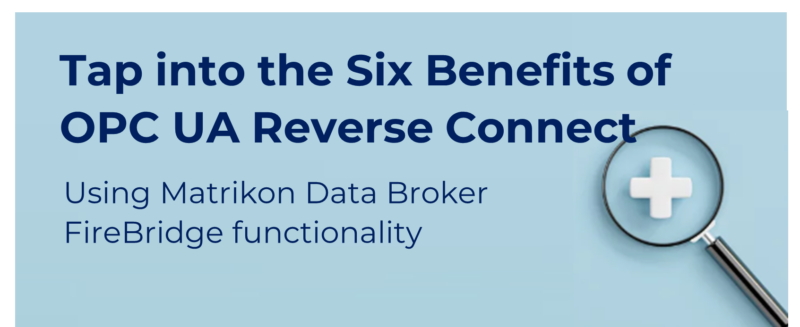SPONSORED BY: MATRIKON
6 Benefits of OPC UA Reverse Connect
In the era of business digitalization, enterprise-wide sustainable, efficient, and secure OT data connectivity is paramount. While using OPC UA Reverse Connect, a feature of the OPC UA Standard, quickly became a cyber security best practice for securely sharing OT data between OPC UA servers and clients across firewalls, it turns out that this functionality offers many additional benefits.
An example of an application that puts the full power of UA Reverse Connect at end-users’ disposal is Matrikon Data Broker (MDB) via its FireBridge functionality. As an open connectivity application, MDB works with all 3rd party OPC UA applications (and OPC Classic applications via Matrikon UA Tunneller).
Without further ado, the following are the top six benefits OPC UA Reverse Connect offers:
Benefit 1: Security First
Traditional OPC UA connections require that a network port be opened on the UA server side, so an OPC UA client can call the UA server. While the UA client/server communications are secure, the open port on the server side of a firewall could potentially make it a target for network attacks. Using OPC UA Reverse Connect, MDB FireBridge enables the initiation of a UA connection from the UA server side of a firewall back to a UA client. The result? No incoming firewall ports on the UA server side need to be opened, which reduces the attack surface and enhances security.
Benefit 2: Simplicity in Firewall and Network Configuration
With OPC UA Reverse Connect, UA servers are the ones initiating UA connections. This circumvents the need to configure firewalls and network rules for each server since UA clients do not need to initiate the call. This simplifies the process and saves considerable configuration effort, a notable advantage for large networks. As a corollary to this benefit, this infrastructure setup simplification (such as requiring fewer firewall exceptions) also reduces the amount of red tape.
Benefit 3: Smooth NAT Traversal
Network Address Translation (NAT) can be an obstacle in traditional connections, as it may obscure a UA server’s real IP address from the UA client. OPC UA Reverse Connect elegantly solves this problem by having the server reach out to the client, which eliminates the issues associated with NAT.
Benefit 4: Scalability
One of the standout features of OPC UA Reverse Connect is the way it facilitates network architecture scalability. This happens because adding new servers doesn’t necessitate changes in the firewall or network configurations. This simplifies the deployment of additional OT devices and servers which, enhances network scalability.
Benefit 5: Promoting Interoperability
OPC UA is platform-agnostic, supporting a wide range of platforms and languages. By standardizing on OPC UA Reverse Connect functionality, companies can utilize a consistent method for enabling network traversal regardless of the types of platforms used throughout their networks. This promotes interoperable environments. For example, MDB FireBridge runs natively on Microsoft Windows and Linux container environments.
Benefit 6: Edge Computing Made Easier
Edge computing scenarios often involve intermittently connected systems or those with dynamic IP addresses. Here, use of OPC UA Reverse Connect is a great solution because it has the server initiate the connection with the OPC UA client – effectively eliminating the need for the UA client to know the UA Server’s IP address ahead of time.
In closing, while OPC UA Reverse Connect and its implementation through Matrikon Data Broker’s FireBridge functionality are best known for their ability to enable secure, cross-firewall, OPC UA client/server connections, there are many additional benefits this powerful functionality has to offer. As we continue to strive for efficient, secure, and interoperable systems, innovative applications like MDB are leading the charge in transforming OT data access and interoperability across the IT and OT landscape.
Discover what MDB can do for you now!
Revolutionize Modbus Infrastructure with Modbus MDBA

Modbus users can now use Modbus Adapter for Matrikon Data Broker (Modbus MDBA) to enhance their Modbus infrastructure with advanced OPC UA-based functionality. By leveraging the Modbus MDBA, users can keep their existing Modbus infrastructure while adding context to their data, making it meaningful to a broader range of consumers.
Shifting to the native OPC UA environment, Modbus MDBA offers lets users securely expand their data’s visibility enterprise-wide. With Modbus MDBA security features like data encryption, certificate-based authentication, and Reverse Connect functionality, users can eliminate the IT/OT gap they typically face when sharing OT data outside the OT network.
The Modbus MDBA leverages Matrikon Data Broker’s ability to consolidate data sources into a single access point, providing a convenient, centralized location for all their OT data. Breathe new life and functionality into your Modbus infrastructure with the Modbus MDB Adapter.
Finally, unlike older Modbus to OPC Classic solutions, which had to run on Windows, Modbus MDBA solutions run on Windows and Linux containers, allowing users to build architectures that best fit their needs.
Learn more about Modbus MDBA here.
Professional DCOM Assessment Services
To help customers simplify the DCOM assessment and preparation process, Matrikon offers a Matrikon DCOM Checkup Service where a Matrikon OPC expert:
- Femotely inspects a customer site’s OPC infrastructure and assesses potential DCOM risks
- Compiles a report of the OPC security health findings and reviews it with the customer
- Provides a prioritized action plan for eliminating the identified risks
Download the Matrikon DCOM Checkup Service datasheet or contact Matrikon directly at opcsales@matrikonopc.com to learn more or get started.
